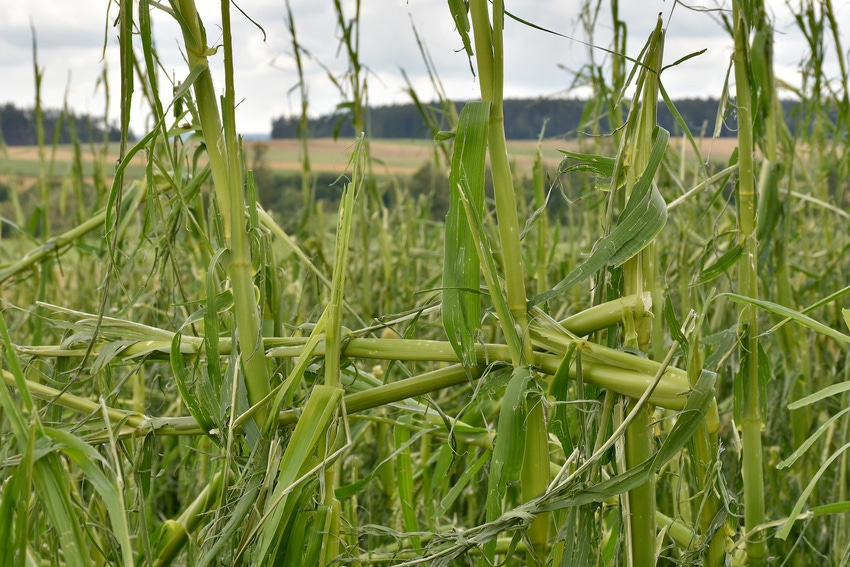
Timely planting this spring and favorable growing conditions during May and most of June resulted in good-to-excellent corn and soybean crop conditions in many areas. However, severe storms in Minnesota and other Upper Midwest states during July has caused significant crop damage in some locations and raised questions about the final quality of the 2020 crop.
The severe storms in July have caused widespread wind and hail damage to crops across Minnesota, as well as potions of Wisconsin, Iowa, North and South Dakota. The wind damage to crops resulted leaning and flattening some corn fields and caused lodging in small grain crops. There may be minimal loss of yield potential, depending on the severity of the wind damage; however, there will be some harvest challenges and potential for further yield loss closer to maturity. The wind damage may have also caused some green snap damage in certain corn hybrids, which would likely result in greater yield reductions.
The greatest crop damage from the recent severe storms was due to significant hail damage across some rather widespread areas in Minnesota and surrounding states. The hail damage hit at a particularly vulnerable stage of development for corn in many locations. Much of the corn across the Upper Midwest was tasseling and silking from July 6 to 20. The tasseling and silking process must be completed to ensure good pollination to produce a viable ear of corn on a plant. If severe hail damage prevents the completion of the pollination process, it can result in significant yield loss in severely damaged corn fields. According to University of Minnesota data, corn that is 60 percent defoliated by hail at the time of tasseling will have a 42 percent or more loss of yield. If the hail damage was light to moderate, it is best to wait 7-10 days to fully evaluate the extent of the damage.
The soybean crop also received severe hail damage in some areas, with some soybeans being completely destroyed. Similar to corn, it is best to wait 7-10 days on soybeans that were partially damaged by the hail to fully evaluate the hail loss and final yield potential. Soybean plants that are still producing auxiliary buds may have some re-growth of the plant after hail. At certain stages of development, soybeans can adjust to reduced stands, with limited loss of production potential. In early stages of growth, soybean stands can be reduced by up to 50 percent and have less than a 25 percent yield reduction. However, as the soybeans reach the blooming stage, as many soybeans have this year, and there is significant defoliation along with stand reductions, the yield loss from hail can increase.
There could be further losses that result from the hail damage later in the growing season. Many times, soybean plants have bruises and stem damage from hail, which can result in plants breaking over prior to harvest. Similarly, corn can have stalk damage from the hail that leads to more potential for stalk diseases and potential for stalk breakage and corn lodging at harvest time. Farm operators with significantly damaged corn and soybean fields may want to adjust harvest schedules to combine those fields as soon as they reach maturity to avoid further harvest losses.
Producers that hat had significant hail damage should contact their crop insurance agent before destroying the crop in the field. Farmers that do need to destroy hail-damaged crops may want to consider seeding a cover crop to protect against soil erosion and to control weed populations. Livestock producers may also be able to seed a cover crop that can provide them with some addition forage this fall. University of Minnesota Extension has some good resources on hail damage and cover crops.
Portions of Minnesota and the surrounding states have received nearly double the normal precipitation amount in late June and the first three weeks of the month. Some areas have received 5-8 inches of rainfall, or more, during individual storms during that time period. Very hot and humid weather across the Upper Midwest raised dew points to extremely high levels creating numerous thunderstorms with excessive rainfall amounts. This has resulted in some large drown-out damage in corn and soybean fields, as well as continual saturated soil conditions that are not very conducive to good crop growing conditions. One concern that has developed as a result of the excessive rainfall levels was the loss or lack of available nitrogen for the rapidly growing corn. Producers should evaluate the condition of the corn crop before deciding to invest in supplemental nitrogen applications this late in the 2020 growing season.
Many corn producers are now applying fungicide to their corn fields to reduce losses from corn diseases. Farmers with hail-damaged cornfields should thoroughly evaluate the yield potential of the corn following the hail before spending the extra investment on fungicide for the corn. It should be pointed out that the fungicide treatments in corn generally treat leaf fungal diseases and will not be effective to control stalk rot and other stalk diseases that resulted from the hail, which are bacterial type diseases.
In areas of Minnesota and many portions of the Upper Midwest that have not been impacted by the severe storms, crop conditions have been quite favorable. Corn and soybean development for 2020 in most areas of southern Minnesota are 7-10 days ahead of normal. Adequate soil moisture, together with the warmer-than-average daytime and nighttime temperatures in late June and the first three weeks of July, has resulted in a rapid growth of the corn and soybean crop in the region. The accumulation of growing degree units (GDUs) at the U of M Southern Minnesota Research Center totaled 1,306 from May 1 through July 15, 2020, which is about 10 percent ahead of normal GDU accumulation for that date. This is a big improvement from 2019 when the GDU accumulation at Waseca was only 1,132 on July 15.
The Minnesota crop ratings in the weekly USDA Crop Progress Reports have remained fairly steady in recent weeks. The July 13 report indicated that 85 percent of the corn and 83 percent of the soybeans in Minnesota were rated good/excellent, with only 3 percent of both crops rated poor/very poor. By comparison, at this same time in 2019, only 58 percent of the corn and 60 percent of the soybeans were rated good/excellent. As of July 13, the good/excellent rating for corn in other states were Iowa at 83 percent, South Dakota at 82 percent, Wisconsin at 81 percent, Nebraska and North Dakota at 70 percent. The good/excellent soybean ratings on July 13 were 83 percent in Iowa and Wisconsin, 77 percent in South Dakota, 73 percent in Nebraska and 67 percent in North Dakota.
Nationally in the July 13 USDA report, 69 percent of the corn and 68 percent of the soybeans were rated good/excellent. The lowest crop ratings were in the eastern Corn Belt, where good/excellent ratings for both crops were near or below 60 percent. There is growing concern with dry soil conditions and moderate drought in portions of the eastern Corn Belt, as well as in western Iowa and portions of the Plains states. A year ago in mid-July, USDA rated 58 percent of the U.S. corn crop and 54 percent of the soybeans as good/excellent.
About the Author(s)
You May Also Like






